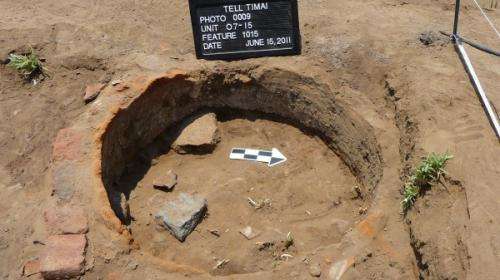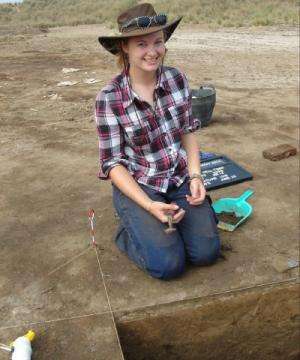Archaeologists unearth ancient coins and dietary options

Finding a cache of 2200-year-old coins buried in the remains of an Egyptian house sparked honours student Liesel Gentelli's interest in coins, inspiring her to pursue postgraduate studies in forensics.
Ms Gentelli is one of two UWA archaeologists invited to excavate Tell Timai, the remains of the Greco-Roman town of Thmuis in Egypt.
A tell is a large mound formed by the remains of an abandoned town or city, and Thmuis was a port on a former Nile delta channel which has since silted up.
She says the coins she discovered during the dig were probably votive offerings placed under the building's foundation to bring prosperity to its inhabitants.
The cache included 13 individual coins from the reigns of Ptolemy II, III and IV, making the building no older than 221 BCE.
The University of Hawaii invited Ms Gentelli and UWA archaeologist Sean Winter to participate in digs at the tell, which is threatened by encroaching developments.
Dr Winter was part of a small international team working at another part of the 91ha site which appears to have been a large open-sided shed.
He says they found an unusually large number of baker's ovens for Egypt at that point in time, indicating the building may have been an industrial-scale bakery or perhaps a tavern.
"Nowhere in the published literature can we find an equivalent number of ovens in the same place," he says.

They used the remains of ceramics, coins and charcoal to date the building to between 100 BCE and perhaps 10 CE.
Of particular interest is the former building's rubbish pit, from which they identified mammal, bird, fish and mollusc remains.
Together with remains of amphorae—large stone urns used to transport fish sauce, wine, oil and the like—they built up a complex picture of Thmouis people's dietary options and sources.
He says oysters, for example, swam up the Nile from the Mediterranean.
The researchers inferred this by comparing the oysters shellfish assemblage with others, including specimens from the former Red Sea port of Berenike.
"At that site all the shellfish were derived locally and comprised species that came from the Red Sea," he says.
"In contrast all of the shellfish that we can identify in our assemblage comprise species native to the Mediterranean."
He has written a paper, "Food Consumption During the First Century BCE at Thmouis" with co-authors Colleen Westmor and Courtney Bobik, which is due to be published next year.
More information: Winter, S., Westmor, C. & Bobik, C. (In-press). "Food Consumption During the First Century BCE at Thmouis." In Pinarello, M., Woo, J., Lundock , J. & Walsh, C. (eds.) Current Research in Egyptology 15. Oxbow.
Provided by Science Network WA



















